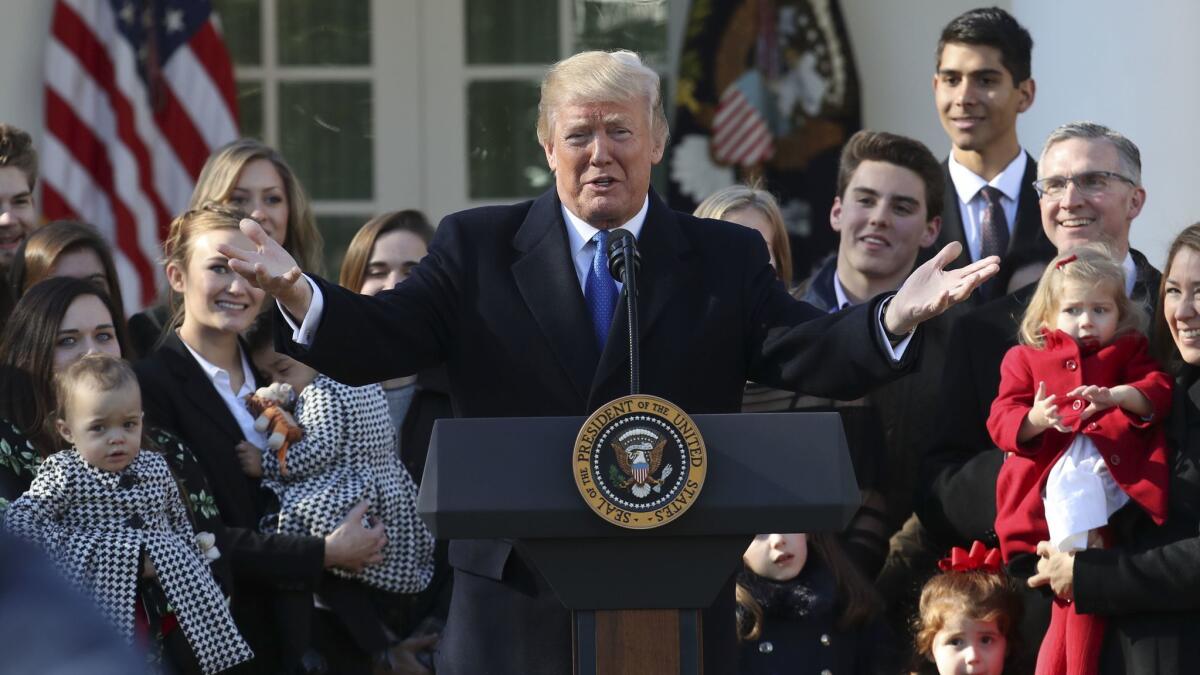Op-Ed: Trump’s changes to Title X put the health of low-income women in danger

- Share via
The Trump administration has a message for American women: Your health doesn’t count.
The Department of Health and Human Services recently finalized a set of onerous restrictions on clinics that participate in the federal Title X program, which funds free and low-cost family planning services.
HHS’ new rule was accompanied by an assessment of its probable costs and benefits. Conspicuously absent from the tally: any acknowledgment of harms that the rule will impose on low-income women by reducing their access to affordable healthcare.
This week, California announced a lawsuit challenging the rule, which Atty. Gen. Xavier Becerra called “extraordinary overreach.” A coalition of 20 other states filed a separate suit, as did Planned Parenthood and the American Medical Association. More legal challenges are expected.
It’s difficult to estimate how many unintended pregnancies will result from HHS’ new policies.
Title X grants support a variety of health services, including birth control prescriptions, cancer screenings and STD testing. Grant recipients have never been permitted to pay for abortions with program funds, but HHS’ new policy goes further, prohibiting clinics from even referring patients to abortion providers.
The American College of Obstetricians and Gynecologists warned last summer that this ban on referrals would “mislead patients,” “delay their access to abortion care” and put doctors in “ethically compromised positions.” Yet HHS claims the ban is entirely costless.
Even more significant, the new rule requires a complete physical separation between providers of Title X services and abortion providers, including separate entrances, waiting rooms, phone numbers and staff. The requirement is a thinly veiled means of precluding Planned Parenthood, which currently serves more than 40% of Title X patients, from remaining in the program.
Both ACOG and the AMA urged HHS to learn from Texas’ mistakes. When that state excluded Planned Parenthood from its Medicaid program, use of the most effective contraceptives fell 35% and the number of Medicaid-covered births increased 27%. Nevertheless, HHS insists that its own policy “will lead to a better or wider distribution of family planning services.”
“Better” services, in the agency’s view, seem to be the kind offered by religious organizations. Whereas prior regulations required Title X projects to provide a “broad range” of “medically approved” family planning options, the new rule encourages participation by providers who recommend only abstinence or “fertility awareness” (i.e., the rhythm method).
Medical organizations sounded the alarm about this change, too, cautioning that “natural” family planning methods are among the least effective. And again, HHS ignored the experts’ warnings, concluding that a greater focus on non-contraceptive methods would have no harmful effects.
This is not the first time that HHS, under Trump, has refused to reckon with its policies’ consequences for women’s health.
In January, the agency attempted to dramatically expand religious exemptions from the Affordable Care Act’s contraception coverage mandate. HHS acknowledged that, under the new exemptions, thousands of women could be forced to pay out of pocket for birth control that otherwise would have been covered by insurance, but the agency refused to concede that some women might respond to the added expense by forgoing contraception.
And last year, HHS proposed a significant expansion of “conscience protections” for healthcare workers, allowing them to decline to participate in any procedure or service to which they have a religious or moral objection. Here, too, the agency refused to consider costs to women — and other vulnerable groups, like LGBTQ patients — who might be denied care under the rule.
It’s difficult to estimate how many unintended pregnancies will result from HHS’ new policies. It’s even harder to put a dollar value on the costs of such pregnancies, which, as the Brookings Institution explained in a 2011 report, include not just medical expenses but also reduced educational attainment and workforce participation.
But agencies frequently grapple with hard-to-quantify effects in their cost-benefit analyses: dread avoided, lives saved. Indeed, HHS itself is all too willing to tout uncertain outcomes on the benefits side of its ledgers.
Enter the Fray: First takes on the news of the minute »
For example, as a benefit of the aforementioned “conscience protections” rule, the agency cited increased diversity in the medical field. HHS’ theory was that “people with a variety of moral, religious, and philosophical backgrounds” would become interested in healthcare jobs if assured that the work wouldn’t require them to violate their beliefs.
This sort of analytical cherry-picking — highlighting potential effects that support the agency’s preferred course of action, disregarding those that don’t — isn’t just misleading. It’s illegal. Under longstanding Supreme Court precedent, agencies must justify their decisions with “reasoned analysis” based on “relevant data.” When evaluating a change in health policy, it’s hard to see what’s more “relevant” than potential harms to public health.
Ever since cost-benefit analysis became standard practice for agencies under the Reagan administration, some progressives have denounced it as a fundamentally dehumanizing procedure, one that reduces complex experiences to numbers in a spreadsheet. But surely putting a price tag on pain is preferable to ignoring it altogether — to telling some people that, in the eyes of the government, their suffering simply doesn’t exist.
That sort of gaslighting might play well for the administration on Twitter or the White House lawn, but it won’t fly in federal court.
Jack Lienke is the regulatory policy director of the Institute for Policy Integrity at New York University School of Law.
Follow the Opinion section on Twitter @latimesopinion or Facebook
More to Read
A cure for the common opinion
Get thought-provoking perspectives with our weekly newsletter.
You may occasionally receive promotional content from the Los Angeles Times.









